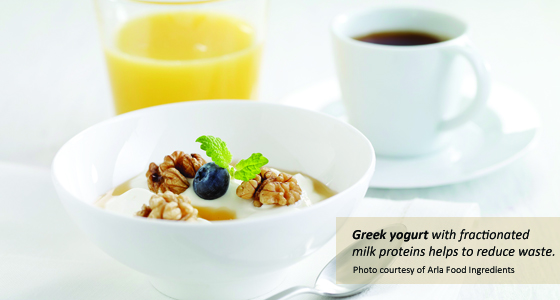Managing Muscle and Bone Mass
NUTRACEUTICALS

Muscle and bone loss both occur in our bodies as we age. What may not always be obvious is that the two can be related. Bodies may get weaker as muscle mass is lost, potentially leading to an increased risk for falls and broken bones.
LeBrasseur et al. (2012) presented data supporting the integrated nature of skeletal muscle and bone and provided insights into potential biomarkers that reflect the health of the musculoskeletal system. The researchers reviewed records from a long-standing Mayo Clinic study of bone health involving 272 women and 317 men ages 20–97, examining the association of skeletal muscle mass with bone architecture and strength. They found that muscle mass is associated with bone strength at particular places in the body. They also showed that the higher the level of the circulating protein, IGFBP-2, the lower the relative muscle mass was overall. “We found IGFBP-2, which has already been linked to osteoporotic fractures in men, is a negative biomarker of muscle mass in both sexes,” said lead author Nathan LeBrasseur, Dept. of Physical Medicine and Rehabilitation and the Robert and Arlene Kogod Center on Aging at Mayo Clinic (Mayo, 2012).
Protein and vitamin D are two nutrients that have been shown to benefit both bone and muscle loss. Here is a look at these as well as other nutritional ingredients that are believed to help maintain muscle mass or slow the loss of bone and muscle.
Muscle Loss
The process of losing muscle mass as people age is called aging sarcopenia. It begins around the age of 25, but it becomes more noticeable after age 65. According to information from the U.S. Dairy Export Council (USDEC), Arlington, Va. (www.usdec.org, www.innovatewithdairy.com), this degenerative loss of skeletal muscle occurs at a rate of 3–8% per decade after the age of 30 and accelerates with advancing age. Protein, vitamin D, and antioxidants are believed to help in maintaining muscle mass.
• Protein. Robinson et al. (2012) discussed the role of protein in sarcopenia, commenting that protein and/or amino acid supplementation have the potential to slow sarcopenic muscle loss. Dietary protein provides amino acids that are needed for the synthesis of muscle protein, and importantly, absorbed amino acids have a stimulatory effect on muscle protein synthesis after feeding. Manders et al. (2012) discussed the fact that leucine exhibits strong insulinotropic characteristics, which may increase amino acid availability for muscle protein synthesis and reduce muscle protein breakdown. Branched-chain amino acids, primarily leucine, increase the activation of pathways involved in muscle protein synthesis through insulin-dependent and independent mechanisms.
Information provided by USDEC suggests that total protein intake for older persons should be slightly higher such as a 1–1.5 g/kg/day range. In addition, emerging research shows that spacing higher protein intakes evenly across meals may help preserve muscles in older adults to maintain their active lifestyle. Dairy protein benefits are of particular interest to today’s aging population looking to maintain a healthy, active lifestyle. “The nutritional benefits of dairy products and ingredients dovetail perfectly with aging-related health concerns,” said Vikki Nicholson, Senior Vice President, Global Marketing, USDEC. “We know that U.S. consumers perceive foods made with dairy as desirable, natural, and wholesome. But the opportunities for food and beverage manufacturers across the globe to leverage dairy proteins in product innovations to boost protein content and reach the aging consumer are outstanding.”
Research shows that compared to most other protein sources, whey protein has more of the branched-chain amino acids, leucine, isoleucine, and valine, which are beneficial for building lean muscle. Emerging research shows that whey proteins, which are high-quality, dairy-derived proteins, can provide an anabolic advantage over other proteins in promoting muscle protein synthesis, or the making of new muscle. Whey protein’s advantage in this is attributed to the high level of leucine it contains.
--- PAGE BREAK ---
USDEC has developed a number of prototypes utilizing dairy protein to target an aging population. A few of these examples include Strawberry Sunrise Waffle—a nutritious, protein- and calcium-packed yogurt-infused waffle; Bread Pudding for the Ages—a delicious and nutritious sweet potato bread pudding; and Wellness Wafer, which delivers high quality dairy protein in a convenient, crunchy snack format.
 Innovations in whey protein ingredients make it easier for manufacturers to add this protein to a myriad of foods and beverages. Arla Foods Ingredients, Viby J, Denmark (www.arlafoodsingredients.com), introduced in 2012 Lacprodan® DI-7017, a new generation of pure whey protein concentrate that is stable in ultra-high temperature formulations at neutral pH, offering companies the opportunity to create a 100% whey-based ready-to-drink beverage that is more effective, easier to formulate, and better-tasting. In January 2013, the company launched an innovative protein solution that enables yogurt manufacturers to produce Greekstyle yogurts in their existing plants with dramatically reduced levels of wastage. Nutrilac® proteins for Greek-style yogurt are designed to be used in conjunction with Arla Foods Ingredients’ “quick” process—a manufacturing technique that eliminates the need for the whey separation step associated with traditional Greek yogurt making. Nutrilac proteins are manufactured from specially selected fractionated milk proteins.
Innovations in whey protein ingredients make it easier for manufacturers to add this protein to a myriad of foods and beverages. Arla Foods Ingredients, Viby J, Denmark (www.arlafoodsingredients.com), introduced in 2012 Lacprodan® DI-7017, a new generation of pure whey protein concentrate that is stable in ultra-high temperature formulations at neutral pH, offering companies the opportunity to create a 100% whey-based ready-to-drink beverage that is more effective, easier to formulate, and better-tasting. In January 2013, the company launched an innovative protein solution that enables yogurt manufacturers to produce Greekstyle yogurts in their existing plants with dramatically reduced levels of wastage. Nutrilac® proteins for Greek-style yogurt are designed to be used in conjunction with Arla Foods Ingredients’ “quick” process—a manufacturing technique that eliminates the need for the whey separation step associated with traditional Greek yogurt making. Nutrilac proteins are manufactured from specially selected fractionated milk proteins.
• Vitamin D. Robinson et al. (2012) discussed the role of vitamin D and antioxidants in muscle health. “The vitamin D receptor (VDR) has been isolated from skeletal muscle, indicating that it is a target organ, and polymorphisms of the VDR have been shown to be related to differences in muscle strength,” explained the researchers. “At the genomic level, binding of the biologically active form of the vitamin (1,25-dihydroxyvitamin D) results in enhanced transcription of a range of proteins, including those involved in calcium metabolism.” The researchers added that much of the epidemiological literature is consistent with the possibility that there are direct effects of vitamin D on muscle strength.
• Antioxidants. According to Robinson, damage to biomolecules such as DNA, lipid, and proteins may occur when reactive oxygen species (ROS) are present in cells in excess. In older age, an accumulation of ROS may lead to oxidative damage and contribute to losses of muscle mass and strength. A number of observational studies have shown positive associations between higher antioxidant status and measures of physical function. The researchers cite studies showing inverse relationships between antioxidants such as carotenoids, vitamin E, and selenium and impaired physical function.
Bone Loss
Osteoporosis most commonly occurs in people age 50 and older. While calcium is most associated with bone health, other nutrients such as vitamin D, vitamin K, potassium, fluoride, and magnesium are involved in maintaining bone mass.
• Calcium. It has been shown that when calcium consumption is inadequate, the body uses calcium reserves in the bones, and bone density levels decrease. Protein, vitamin D, vitamin K, and fructooligosaccharides have been shown to have beneficial effects on calcium.
• Protein. According to the U.S. Dept. of Agriculture’s Calcium and Bone Metabolism Laboratory, “bone mineral density may actually benefit from high-protein diets” if “the diet also meet[s] the recommended dietary allowance of calcium and vitamin D.” USDEC cites a study that indicated that low-protein diets may decrease intestinal calcium absorption and are associated with reduced bone mass in most observational studies (Kerstetter et al., 2003). Another study published online in the Journal of Clinical Endocrinology and Metabolism showed that consuming a calorie-controlled diet lower in carbohydrates and higher in protein primarily from dairy foods combined with daily exercise had a significantly positive impact on bone health in overweight individuals as well as obese young women. The researchers observed that bone health improvements were particularly evident because of the high density of bone-supporting nutrients such as vitamin D, dairy-based protein, and calcium (Rattue, 2011). USDEC also stressed the importance of consuming recommended amounts of dairy foods for bone health. Milk provides a number of nutrients important for bone development and maintenance, including calcium, vitamin D, vitamin B-12, potassium, phosphorus, magnesium, and zinc.
 • Vitamin D and vitamin K. Vitamins D and K also affect bone health through their relationship with calcium. Vitamin D promotes calcium absorption while vitamin K affects the binding of calcium in the bones. According to PL Thomas, Morristown, N.J. (www.plthomas.com), a growing body of evidence supports a role for vitamin K-2 in bone health. Vitamin K mediates the synthesis of proteins that regulate bone metabolism. Observational studies show that vitamin K-2 levels are associated with lower risk of bone fracture in Japanese women. Both the menaquinone-4 (MK-4) and menaquinone-7 (MK-7) forms of vitamin K-2 have been studied for their role in bone health. PL Thomas offers Natural Vitamin K2 MK-7, a natural extract derived from the Japanese food natto, or fermented soy.
• Vitamin D and vitamin K. Vitamins D and K also affect bone health through their relationship with calcium. Vitamin D promotes calcium absorption while vitamin K affects the binding of calcium in the bones. According to PL Thomas, Morristown, N.J. (www.plthomas.com), a growing body of evidence supports a role for vitamin K-2 in bone health. Vitamin K mediates the synthesis of proteins that regulate bone metabolism. Observational studies show that vitamin K-2 levels are associated with lower risk of bone fracture in Japanese women. Both the menaquinone-4 (MK-4) and menaquinone-7 (MK-7) forms of vitamin K-2 have been studied for their role in bone health. PL Thomas offers Natural Vitamin K2 MK-7, a natural extract derived from the Japanese food natto, or fermented soy.
Frutarom Health, Wädenswil, Switzerland (www.unik2-mk7.com), offers uniK2™ Vitamin K2 MK-7. By activating a protein called osteocalcin and producing optimal binding of calcium in the bones, and by improving the collagen status in bone, vitamin K-2 is effective in improving bone quality and strength. Also derived from natto, uniK2 is available in two levels of concentration as uniK2 MK-7 powder 0.2% and uniK2 MK-7 oil 0.15%. The company in November 2012 announced that uniK2 was self-affirmed GRAS.
--- PAGE BREAK ---
• Prebiotic fiber. Prebiotic fibers such as fructooligosaccharides and inulin have been shown to aid calcium absorption. NUTRAFLORA® prebiotic fiber from Ingredion, Westchester, Ill. (www.ingredion.com), is derived from sugar cane utilizing a biofermentation proprietary process and non-GMO ingredients, resulting in the purest form of short-chain fructooligosaccharide, a prebiotic fiber that supports immune health and calcium absorption. The company in March 2013 announced that Health Canada approved NUTRAFLORA as a dietary fiber source. The approval allows for it to be declared as a fiber source in food products as permitted by the Food and Drug Regulations.
An inulin enriched with oligofructose, Orafti® Syngergy1, from BENEO-Orafti, Morris Plains, N.J. (www.beneo-orafti.com), has been shown to increase calcium absorption and bone density. According to company information, this was demonstrated in a double-blind study where 100 adolescent subjects were given either 8 g of Orafti Synergy1 or an equivalent amount of placebo every day for a year. Calcium absorption and bone density were far higher in those who consumed Orafti Synergy1. At six-week and one-year interventions, calcium absorption had increased by 25%. After one year, bone mineral density was significantly higher. The researchers also measured bone mineral content and found that in the subjects who took Orafti Synergy1, bone calcium accretion increased by an extra 30 mg per day, proof that the extra calcium was actually deposited in the bones.
• Tripotassium citrate. Jehle et al. (2012) demonstrated that treatment with Active Pharmaceutical Ingredient Tripotassium Citrate (TPC) from Jungbunzlauer, Newton Centre, Mass. (jungbunzlauer.com), led to significant increases in bone mineral density and improvement of bone microarchitecture in healthy elderly people. The randomized, double-blind, placebo-controlled study included 201 subjects older than 65 years with normal baseline bone mineral density who received either 60 mEq/day of alkalizing TPC via Urocit-K tablets from Mission Pharmacal, San Antonio, Texas, or placebo for 24 months. Both groups were supplemented with 500 mg of calcium and 400 IU of vitamin D-3. The researchers concluded that TPC “administered in a background of vitamin D and calcium supplements is well-tolerated and constitutes an inexpensive intervention to increase bone areal bone mineral density and trabecular volumetric bone mineral density and to improve bone microarchitecture in healthy elderly people with normal bone mass” (Jungbunzlauer, 2012). In January 2013, Jungbunzlauer introduced tricalcium citrate GN for dietary supplements. The micronized and fine powder form is used for calcium fortification in beverages, dairy products, fruit preparations, clinical nutrition, and infant formula.
• Collagen peptides. Collagen peptides are mostly associated with joint health, but have also been shown to provide bone health benefits. For example, lab studies indicate that Wellnex™ collagen peptides from Nitta Gelatin, Morrisville, N.C. (www.nitta-gelatin.com), encourage healthy bone metabolism. A high amount of the dipeptides prolinehydroxyproline and hydroxyproline-glycine are released into human peripheral blood after ingestion of Wellnex collagen peptides.
These dipeptides are resistant to peptidase cleavage and are essential elements to bone metabolism. Both dipeptides are said to help maintain normal bone density by controlling differentiation of osteoclast and osteoblast cells thereby encouraging healthy bone metabolism.
 Linda Milo Ohr,
Linda Milo Ohr,
Contributing Editor,
Denver, Colo.
[email protected]
References
Jehle, S., Hulter, H.N., and Krapf, R. 2012. Effect of potassium citrate on bone density, microarchitecture, and fracture risk in healthy older adults without osteoporosis: a randomized controlled trial. J. Clin. Endocrinol. Metab. First published online Nov. 15, http://jcem.endojournals.org/content/early/2012/11/14/jc.2012-3099.
Jungbunzlauer. 2012. Tripotassium citrate increases bone density in healthy individuals by neutralizing acidity of modern diet. Press Release, Nov. 23. Jungbunzlauer, Newton Centre, Mass.
Kerstetter, J.E, O’Brien, K.O., and Insogna, K.L. 2003. Low protein intake: the impact on calcium and bone homeostasis. J. Nutr. 133: 855S-861S.
LeBrasseur, N. K., Achenbach, S. J., Melton, L.J., Amin, S. and Khosla, S. 2012. Skeletal muscle mass is associated with bone geometry and microstructure and serum insulin-like growth factor binding protein-2 levels in adult women and men. J. Bone Miner. Res. 27: 2159-2169.
Manders, R.J., Little, J.P., Forbes, S.C., and Candow, D.G. 2012. Insulinotropic and muscle protein synthetic effects of branched-chain amino acids: potential therapy for type 2 diabetes and sarcopenia. Nutrients. 4(11): 1664-1678.
Mayo. 2012. Study finds gender differences in health muscles, bones. Press release, June 20. Mayo Clinic, Rochester, Minn.
Rattue, G. 2011. Protecting bones during weight loss—Eat protein-rich foods. Medical News Today. MediLexicon Intl., www.medicalnewstoday.com/articles/238518.php.
Robinson, S., Cooper, C., and Sayer, A.A. 2012. Nutrition and sarcopenia: a review of the evidence and implications for preventive strategies. J. Aging Res. vol. 2012, article ID 510801, doi: 10.1155/2012/510801.


